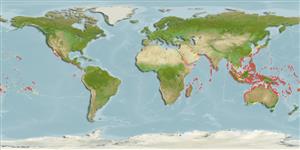Common names from other countries
Environment: milieu / climate zone / depth range / distribution range
экология
морской ассоциированный с рифами; пределы глубины 0 - 20 m (Ref. 106975), usually 0 - 5 m (Ref. 89972). Tropical; 35°N - 40°S
Indo-Pacific: from the east coast of Africa and the Red Sea east to the Society Islands.
Size / Вес / Возраст
Maturity: Lm ? range ? - ? cm
Max length : 14.0 cm TL самец/пол неопределен; (Ref. 9710)
колючие лучи спинного плавника (общее число) : 13 - 14; членистые (мягкие) лучи спинного плавника (общее число) : 7 - 9; колючие лучи анального плавника: 3; членистые (мягкие) лучи анального плавника: 5. Thie species is distinguished by the following set of characters: pectoral-fin rays 17-20 (mode 18), some rays branched in specimens over ca. 40 mm SL; dorsal-fin soft rays 7-9 (8); scale rows in longitudinal series 40-46 (43); underside of lower jaw scaleless; gill rakers 11-15 (13); with nasal spine; lateral lacrimal spine is usually present; suborbital spines 2, first spine below eye, second spine at end of suborbital ridge; no interorbital and coronal spines; opercle with a large dark blotch; no dark blotch on subopercle or spinous portion of dorsal fin (Ref. 106975).
Found in rock crevices in reef flats, shallow lagoons, and channels. Feeds mainly at night on small shrimps, crabs, and polychaetes. Anterolateral glandular groove with venom gland (Ref. 57406). Solitary and cryptic (Ref 90102).
Life cycle and mating behavior
Maturities | размножение | Spawnings | Egg(s) | Fecundities | личинки
Motomura, H., R. Causse and C.D. Struthers, 2015. Redescription of the Indo-Pacific scorpionfish Scorpaenodes guamensis (Quoy & Gaimard 1824) (Scorpaenidae), a senior synonym of seven nominal species. Zootaxa 4067(3):345-360. (Ref. 106975)
Статус Красного Списка МСОП (Ref. 130435)
CITES (Ref. 128078)
Not Evaluated
Использование человеком
рыболовство: интереса не представляет
дополнительная информация
инструменты
Специальные отчеты
Скачать в формате XML
ресурсы в Интернет
Estimates based on models
Preferred temperature (Ref.
115969): 24.3 - 29.3, mean 28.2 (based on 3057 cells).
Phylogenetic diversity index (Ref.
82804): PD
50 = 0.5000 [Uniqueness, from 0.5 = low to 2.0 = high].
Bayesian length-weight: a=0.01413 (0.00918 - 0.02174), b=3.00 (2.88 - 3.12), in cm Total Length, based on LWR estimates for this species & (Sub)family-body (Ref.
93245).
Trophic level (Ref.
69278): 3.4 ±0.50 se; based on food items.
устойчивость к внешним воздействиям (Ref.
120179): средний (среднего размера), минимальное время удвоения популяции 1.4-4.4 года (Preliminary K or Fecundity.).
Fishing Vulnerability (Ref.
59153): Low vulnerability (10 of 100).
